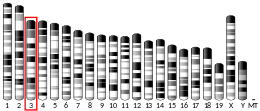Monocarboxylate transporter 1
Mammalian protein found in Homo sapiens From Wikipedia, the free encyclopedia
Monocarboxylate transporter 1 is a ubiquitous protein that in humans is encoded by the SLC16A1 gene (also known as MCT1).[5][6][7] It is a proton coupled monocarboxylate transporter.
Biochemistry
Detailed kinetic analysis of monocarboxylate transport in erythrocytes revealed that MCT1 operates through an ordered mechanism. MCT1 has a substrate binding site open to the extracellular matrix which binds a proton first followed by the lactate anion. The protein then undergoes a conformational change to a new 'closed conformation that exposes both the proton and lactate to the opposite surface of the membrane where they are released, lactate first and then the proton. For net transport of lactic acid, the rate-limiting step is the return of MCT1 without bound substrate to the open conformation. For this reason, exchange of one monocarboxylate inside the cell with another outside is considerably faster than net transport of a monocarboxylate across the membrane.[citation needed]
MCT1 can be upregulated by PPAR-α, Nrf2, and AMPK.[8]
Animal studies
Overexpression of MCT1 has been shown to increase the efficacy of an anti-cancer drug currently undergoing clinical trials called 3-bromopyruvate in breast cancer cells.[9]
Clinical significance
Summarize
Perspective
Most cases of alveolar soft part sarcoma show PAS(+), diastase-resistant (PAS-D (+)) intracytoplasmic crystals which contain CD147 and monocarboxylate transporter 1 (MCT1).[10] Overexpression of MCT1 in pancreatic beta cells leads to hyperinsulinism during exercise.[11]
Hyperinsulinemic hypoglycemia, familial, 7 (HHF7) is an autosomal dominant disease on the SLC16A1/MCT gene on chromosome 1p13.2. It causes hyperinsulinemic hypoglycemia, where hyperinsulinism is exercise-induced.[12]
Monocarboxylate transporter 1 deficiency (MCTD1) is an autosomal dominant and recessive disease on the SLC16A1/MCT1 gene on chromosome 1p13.2. It causes poor feeding and vomiting, intellectual disability, ketotic hypoglycemia, ketoacidosis, ketonuria, with episodes brought on by fasting or infection.[13]
Erythrocyte lactate transporter defect (formerly, myopathy due to lactate transport defect) is an autosomal dominant disease on the SLC16A1/MCT gene on chromosome 1p.13.2. It causes exercise-induced muscle cramping, stiffness, and fatigue (exercise intolerance); symptoms may also be induced by heat. Although symptoms present in the muscles, muscle biopsy and EMG are normal. Decreased erythrocyte (red blood cell) lactate clearance, decreased lactate clearance from muscle after exercise, and elevated serum creatine kinase.[14]
References
Further reading
Wikiwand - on
Seamless Wikipedia browsing. On steroids.







